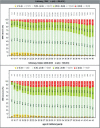The relationship between maternal age, body mass index, and the rate of preterm birth
- PMID: 30257817
- PMCID: PMC6250089
- DOI: 10.4274/jtgga.2018.0057
The relationship between maternal age, body mass index, and the rate of preterm birth
Abstract
Objective: The aim of the present study was to assess the influence of maternal age and maternal body mass index of early pregnancy on the risk of preterm delivery.
Material and methods: The study included 2.1 million liveborn single newborns with documented data at perinatal surveys. Statistical analyses were performed using the SPSS statistics program.
Results: The risk of preterm births increased in obese women and in women with advanced age.
Conclusion: Strategies should be developed to reduce preconceptional body mass index, and guidelines are required to help advise women who postponed childbearing.
Keywords: Maternal age; body mass index; obesity; premature birth; Germany.
Conflict of interest statement
Figures





Similar articles
-
Associations of Maternal Diabetes and Body Mass Index With Offspring Birth Weight and Prematurity.JAMA Pediatr. 2019 Apr 1;173(4):371-378. doi: 10.1001/jamapediatrics.2018.5541. JAMA Pediatr. 2019. PMID: 30801637 Free PMC article.
-
The Preterm Prediction Study: association between maternal body mass index and spontaneous and indicated preterm birth.Am J Obstet Gynecol. 2005 Mar;192(3):882-6. doi: 10.1016/j.ajog.2004.09.021. Am J Obstet Gynecol. 2005. PMID: 15746686
-
Effect of maternal height and weight on risk for preterm singleton and twin births resulting from IVF in the United States, 2008-2010.Am J Obstet Gynecol. 2013 Oct;209(4):349.e1-6. doi: 10.1016/j.ajog.2013.05.052. Epub 2013 May 30. Am J Obstet Gynecol. 2013. PMID: 23727520
-
Swedish and American studies show that initiatives to decrease maternal obesity could play a key role in reducing preterm birth.Acta Paediatr. 2014 Jun;103(6):586-91. doi: 10.1111/apa.12616. Epub 2014 Mar 25. Acta Paediatr. 2014. PMID: 24575829 Review.
-
Association between perinatal outcomes and maternal pre-pregnancy body mass index.Obes Rev. 2016 Nov;17(11):1091-1102. doi: 10.1111/obr.12455. Epub 2016 Aug 18. Obes Rev. 2016. PMID: 27536879 Review.
Cited by
-
Reducing the Rate of Premature Births through Early Diagnosis and Pregnancy-Adapted Treatment of Hypothyroidism.Geburtshilfe Frauenheilkd. 2023 Oct 5;83(11):1361-1370. doi: 10.1055/a-2103-8143. eCollection 2023 Nov. Geburtshilfe Frauenheilkd. 2023. PMID: 38024217 Free PMC article.
-
Obesity in pregnant women: a 20-year analysis of the German experience.Eur J Clin Nutr. 2021 Dec;75(12):1757-1763. doi: 10.1038/s41430-021-00981-8. Epub 2021 Oct 26. Eur J Clin Nutr. 2021. PMID: 34702964 Free PMC article.
-
A comparison of international clinical practice guidelines for postpartum venous thromboembolism prophylaxis.BMC Pregnancy Childbirth. 2025 Feb 12;25(1):150. doi: 10.1186/s12884-025-07246-3. BMC Pregnancy Childbirth. 2025. PMID: 39939968 Free PMC article.
-
The association between operative hysteroscopy prior to assisted reproductive technology and cervical insufficiency in second trimester.Arch Gynecol Obstet. 2021 May;303(5):1347-1352. doi: 10.1007/s00404-020-05863-1. Epub 2020 Nov 20. Arch Gynecol Obstet. 2021. PMID: 33219481
-
The relationship between maternal age, obesity and child mortality: a cross-sectional study using 2013-2014 Demographic and Health Survey in Democratic Republic of the Congo at national, and sub-national levels.Public Health Nutr. 2025 Jan 7;28(1):e20. doi: 10.1017/S1368980024002647. Public Health Nutr. 2025. PMID: 39764640 Free PMC article.
References
-
- National Center for Health Statistics. Birth right for woman aged 40-44 years rose in 2003. New Reports finds; [Internet] http://www.cdc.gov/nchs/pressroom/04facts/birthrates.htm .
-
- Nohr EA, Bech BH, Vaeth M, Rasmussen KM, Henriksen TB, Olsen J. Obesity, gestational weight gain and preterm birth: a study within the Danish National Birth Cohort. Paediatr Perinat Epidemiol. 2007;21:5–14. - PubMed
-
- Ritzinger P, Dudenhausen JW, Holzgreve W. Späte Mutterschaft und deren Risiken. J Endokrinol Reprod. 2011;8:112–22.
-
- Maier JT, Schalinski E, Gauger U, Hellmeyer L. Antenatal body mass index (BMI) and weight gain in pregnancy - its association with pregnancy and birthing complications. J Perinat Med. 2016;44:397–404. - PubMed
-
- Niessen K, Werner-Bierwisch T, Metzing S, Zu Sayn-Wittgenstein F. Mutterschaft ab 35 Jahren: Das Altersrisiko in der Wahrnehmung von Frauen - eine Literaturstudie. Z Geburtsh Neonatol. 2017;221:111–2. - PubMed
LinkOut - more resources
Full Text Sources
Other Literature Sources
